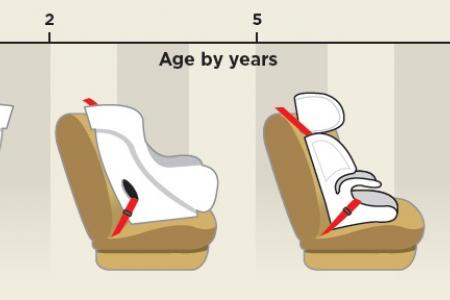After seeing child die after car crash, doctor says something "so that she will never live in guilt"
For parents, nothing is more important than the safety of their child while driving.
Yet, some parents are unwittingly endangering their children's lives by not putting them in child seats.
Dr Andrea Yeo, a consultant in the National University Hospital's Children Emergency Department, knows this first hand.
Three months ago, she attended to a child who was injured in a car accident.
The child died a few hours later.
This affected Dr Yeo so much that she went on Facebook and urged her friends with children to start using child restraints.
She prefaced her Facebook message with this statement: "To all my friends with children that I was previously too afraid to offend, I just need to say something so that I will never live in guilt for having never told you this."
Dr Yeo warned that unrestrained children are especially vulnerable in an accident.
The mother of four told The New Paper: "Children can sustain fatal injuries if they are not properly restrained while travelling in a motor vehicle.
"Even in non-fatal cases, they can sustain serious injuries to the head, spine or internal organs."
The number of drivers here caught for child-restraint offences is steadily rising, figures from the Traffic Police show. (See figures above.)
Between January to June last year, 684 drivers were caught for such offences, compared to 619 for the same period in 2013.
Since Jan 1, 2012, anyone under the height of 1.35m, regardless of age, must be secured in child restraints, booster seats or adjustable seat belts when travelling in a vehicle.
First-time offenders can be fined up to $1,000 or jailed up to three months.
However, just having a child seat is not enough.
HEIGHT & WEIGHT
Children in child restraints are not entirely safe if they are not in the appropriate ones for their height and weight, said Mr Gerard Pereira, 57, operations manager at the Singapore Safety Driving Centre.
He added: "The wrong child restraint may cause fatality or other injuries instead of saving the child."
Mr Bernard Tay, chairman of the Singapore Road Safety Council, explained the importance of child seats, saying: "They function by absorbing and safely distributing crash impact loads over the child's body while holding the child in place.
"Just as for normal adults, using child seats and seat belts may be the difference between life and death."
'To all my friends with children that I was previously too afraid to offend, I just need to say something so that I will never live in guilt for having never told you this.'
- Dr Andrea Yeo in her Facebook post
What you should do with your child in a car

Rear-facing car seat
Birth to Age two*
Buckle infants and children under two in a rear-facing seat until they reach the weight or height limit of the seat. Rear-facing car seats offer the most protection during a collision, said Mr Gerard Pereira."Upon impact, the infant will not fly out of the car seat."
Forward-facing car seat
Age two to five*
When the children get bigger, buckle them in a forward-facing car seat until they are at least five or they reach the weight or height limit of the seat.
Booster seat
Age five to until seat belts fit properly*
Children above five should use booster seats until the seat belt fits properly without booster seats.
Seat belt
Seat belts fit properly without booster seats*
The lap belt should lay across the upper thighs and shoulder belt should lay across the chest and not the neck.
*Apart from their child's age, parents should also consider the size of their child when choosing the appropriate child restraint, said Mr Gerard Pereira of the Singapore Safety Driving Centre. "Asian children tend to be smaller."
WHAT CAN GO WRONG?

Scenario 1 Not wearing seat belt
If the child is not wearing a seat belt during a crash, the impact will throw him or her across the car or even into the windscreen, causing serious injuries, even at 50kmh.

Scenario 2 Child in the back seat, facing forwards
If a child is too small for the car seat, he or she may still get injured in a crash, said Mr Gerard Pereira. The impact of a collision will jolt the child forwards and cause injuries like fractures.

Scenario 3 Child in front seat, facing forwards
When the airbag is activated in a collision, it may injure the child, said Mr Pereira, who does not recommend placing child restraints in the front seat. A child's neck is vulnerable in a frontal collision as it is not fully developed.

Scenario 4 Child in front seat, facing backwards
The airbag deployed in a crash may cause serious injury to the child as it will hit the back of the child seat with considerable force, pushing it up against the front seat and the head rest.
Child-restraint offences in recent years
1,273 - 2013
1,046 - 2012
1,055* - 2011
*Before Jan 1, 2012, child-restraint offences refer to offences for not putting a child under eight in a child restraint or putting them in an unapproved child restraint.
Source: Singapore Police Force
Get The New Paper on your phone with the free TNP app. Download from the Apple App Store or Google Play Store now

